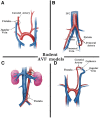The rodent models of arteriovenous fistula
- PMID: 38304139
- PMCID: PMC10830807
- DOI: 10.3389/fcvm.2024.1293568
The rodent models of arteriovenous fistula
Abstract
Arteriovenous fistulas (AVFs) have long been used as dialysis access in patients with end-stage renal disease; however, their maturation and long-term patency still fall short of clinical needs. Rodent models are irreplaceable to facilitate the study of mechanisms and provide reliable insights into clinical problems. The ideal rodent AVF model recapitulates the major features and pathology of human disease as closely as possible, and pre-induction of the uremic milieu is an important addition to AVF failure studies. Herein, we review different surgical methods used so far to create AVF in rodents, including surgical suturing, needle puncture, and the cuff technique. We also summarize commonly used evaluations after AVF placement. The aim was to provide recent advances and ideas for better selection and induction of rodent AVF models. At the same time, further improvements in the models and a deeper understanding of AVF failure mechanisms are expected.
Keywords: arteriovenous fistula; chronic kidney disease; mice; rats; rodent model.
© 2024 Li, Hu, Li, Lu, Guo and Wang.
Conflict of interest statement
The authors declare that the research was conducted in the absence of any commercial or financial relationships that could be construed as a potential conflict of interest.
Figures



Similar articles
-
Comparison of Ellipsys Percutaneous and Proximal Forearm Gracz-Type Surgical Arteriovenous Fistulas.Am J Kidney Dis. 2021 Oct;78(4):520-529.e1. doi: 10.1053/j.ajkd.2021.01.011. Epub 2021 Mar 1. Am J Kidney Dis. 2021. PMID: 33662481
-
Arteriovenous fistula formation with adjuvant endovascular maturation.J Vasc Surg. 2022 Feb;75(2):641-650.e2. doi: 10.1016/j.jvs.2021.08.072. Epub 2021 Sep 8. J Vasc Surg. 2022. PMID: 34506894
-
International Comparisons of Native Arteriovenous Fistula Patency and Time to Becoming Catheter-Free: Findings From the Dialysis Outcomes and Practice Patterns Study (DOPPS).Am J Kidney Dis. 2021 Feb;77(2):245-254. doi: 10.1053/j.ajkd.2020.06.020. Epub 2020 Sep 21. Am J Kidney Dis. 2021. PMID: 32971192
-
Arteriovenous fistula in dialysis patients: Factors implicated in early and late AVF maturation failure.Surgeon. 2016 Oct;14(5):294-300. doi: 10.1016/j.surge.2016.02.001. Epub 2016 Mar 15. Surgeon. 2016. PMID: 26988630 Review.
-
Arteriovenous fistula aneurysmorrhaphy is associated with improved patency and decreased vascular access abandonment.J Vasc Surg. 2023 Mar;77(3):891-898.e1. doi: 10.1016/j.jvs.2022.10.054. Epub 2022 Nov 8. J Vasc Surg. 2023. PMID: 36368647 Review.
References
Publication types
Grants and funding
LinkOut - more resources
Full Text Sources

